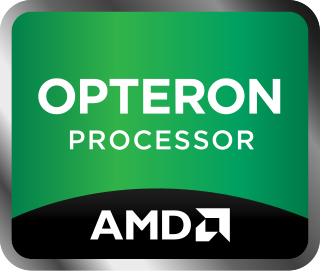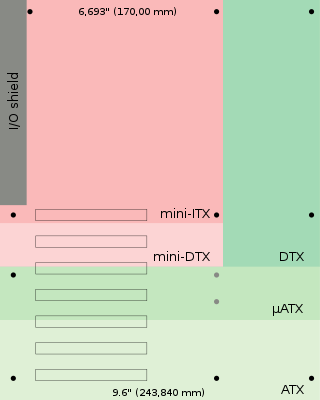Related Research Articles

Advanced Micro Devices, Inc., commonly abbreviated as AMD, is an American multinational semiconductor company based in Santa Clara, California, that develops computer processors and related technologies for business and consumer markets.
HyperTransport (HT), formerly known as Lightning Data Transport, is a technology for interconnection of computer processors. It is a bidirectional serial/parallel high-bandwidth, low-latency point-to-point link that was introduced on April 2, 2001. The HyperTransport Consortium is in charge of promoting and developing HyperTransport technology.

Opteron is AMD's x86 former server and workstation processor line, and was the first processor which supported the AMD64 instruction set architecture. It was released on April 22, 2003, with the SledgeHammer core (K8) and was intended to compete in the server and workstation markets, particularly in the same segment as the Intel Xeon processor. Processors based on the AMD K10 microarchitecture were announced on September 10, 2007, featuring a new quad-core configuration. The most-recently released Opteron CPUs are the Piledriver-based Opteron 4300 and 6300 series processors, codenamed "Seoul" and "Abu Dhabi" respectively.

The front-side bus (FSB) is a computer communication interface (bus) that was often used in Intel-chip-based computers during the 1990s and 2000s. The EV6 bus served the same function for competing AMD CPUs. Both typically carry data between the central processing unit (CPU) and a memory controller hub, known as the northbridge.

The Athlon 64 is a ninth-generation, AMD64-architecture microprocessor produced by Advanced Micro Devices (AMD), released on September 23, 2003. It is the third processor to bear the name Athlon, and the immediate successor to the Athlon XP. The second processor to implement the AMD64 architecture and the first 64-bit processor targeted at the average consumer, it was AMD's primary consumer CPU, and primarily competed with Intel's Pentium 4, especially the Prescott and Cedar Mill core revisions. It is AMD's first K8, eighth-generation processor core for desktop and mobile computers. Despite being natively 64-bit, the AMD64 architecture is backward-compatible with 32-bit x86 instructions. Athlon 64s have been produced for Socket 754, Socket 939, Socket 940, and Socket AM2. The line was succeeded by the dual-core Athlon 64 X2 and Athlon X2 lines.

A coprocessor is a computer processor used to supplement the functions of the primary processor. Operations performed by the coprocessor may be floating-point arithmetic, graphics, signal processing, string processing, cryptography or I/O interfacing with peripheral devices. By offloading processor-intensive tasks from the main processor, coprocessors can accelerate system performance. Coprocessors allow a line of computers to be customized, so that customers who do not need the extra performance do not need to pay for it.

Mini-ITX is a 170 mm × 170 mm motherboard form factor developed by VIA Technologies in 2001. Mini-ITX motherboards have been traditionally used in small-configured computer systems. Originally, Mini-ITX was a niche standard designed for fanless cooling with a low power consumption architecture, which made them useful for home theater PC systems, where fan noise can detract from the cinema experience.

In computer hardware, a CPU socket or CPU slot contains one or more mechanical components providing mechanical and electrical connections between a microprocessor and a printed circuit board (PCB). This allows for placing and replacing the central processing unit (CPU) without soldering.

Socket 939 is a CPU socket released by AMD in June 2004 to supersede the previous Socket 754 for Athlon 64 processors. Socket 939 was succeeded by Socket AM2 in May 2006. It is the second socket designed for AMD's AMD64 range of processors.

Socket 754 is a CPU socket originally developed by AMD to supersede its Athlon XP platform. Socket 754 was the first socket developed by AMD to support their new consumer version of the 64 bit microprocessor family known as AMD64.
AMD Cool'n'Quiet is a CPU dynamic frequency scaling and power saving technology introduced by AMD with its Athlon XP processor line. It works by reducing the processor's clock rate and voltage when the processor is idle. The aim of this technology is to reduce overall power consumption and lower heat generation, allowing for slower cooling fan operation. The objectives of cooler and quieter result in the name Cool'n'Quiet. The technology is similar to Intel's SpeedStep and AMD's own PowerNow!, which were developed with the aim of increasing laptop battery life by reducing power consumption.

The Socket AM2, renamed from Socket M2, is a CPU socket designed by AMD for desktop processors, including the performance, mainstream and value segments. It was released on May 23, 2006, as a replacement for Socket 939.
The AMD Family 10h, or K10, is a microprocessor microarchitecture by AMD based on the K8 microarchitecture. The first third-generation Opteron products for servers were launched on September 10, 2007, with the Phenom processors for desktops following and launching on November 11, 2007 as the immediate successors to the K8 series of processors.

Socket F is a CPU socket designed by AMD for its Opteron line of CPUs released on August 15, 2006. In 2010 Socket F was replaced by Socket C32 for entry-level servers and Socket G34 for high-end servers.
The AMD Quad FX platform is an AMD platform targeted at enthusiasts which allows users to plug two Socket F Athlon 64 FX or 2-way Opteron processors (CPUs) into a single motherboard for a total of four physical cores. This is a type of dual processor setup, where two CPUs are installed on a motherboard to increase computing power. The major difference between the platform and past dual processor systems like Xeon is that each processor has its own dedicated memory stores. The Quad FX platform also has HyperTransport capability targeted toward consumer platforms.

Roadrunner was a supercomputer built by IBM for the Los Alamos National Laboratory in New Mexico, USA. The US$100-million Roadrunner was designed for a peak performance of 1.7 petaflops. It achieved 1.026 petaflops on May 25, 2008, to become the world's first TOP500 LINPACK sustained 1.0 petaflops system.
The AMD 700 chipset series is a set of chipsets designed by ATI for AMD Phenom processors to be sold under the AMD brand. Several members were launched in the end of 2007 and the first half of 2008, others launched throughout the rest of 2008.
The AMD Bulldozer Family 15h is a microprocessor microarchitecture for the FX and Opteron line of processors, developed by AMD for the desktop and server markets. Bulldozer is the codename for this family of microarchitectures. It was released on October 12, 2011, as the successor to the K10 microarchitecture.

Phenom II is a family of AMD's multi-core 45 nm processors using the AMD K10 microarchitecture, succeeding the original Phenom. Advanced Micro Devices released the Socket AM2+ version of Phenom II in December 2008, while Socket AM3 versions with DDR3 support, along with an initial batch of triple- and quad-core processors were released on February 9, 2009. Dual-processor systems require Socket F+ for the Quad FX platform. The next-generation Phenom II X6 was released on April 27, 2010.
Coherent Accelerator Processor Interface (CAPI), is a high-speed processor expansion bus standard for use in large data center computers, initially designed to be layered on top of PCI Express, for directly connecting central processing units (CPUs) to external accelerators like graphics processing units (GPUs), ASICs, FPGAs or fast storage. It offers low latency, high speed, direct memory access connectivity between devices of different instruction set architectures.
References
- ↑ "AMD Announces Initiatives To Elevate AMD64 As Platform For System- And Industry-Wide Innovation". News release. Advanced Micro Devices. June 1, 2006. Archived from the original on June 13, 2006. Retrieved May 29, 2011.
- ↑ Ashlee Vance (April 17, 2007). "High fiber diet gives Intel 'regularity' needed to beat AMD". The Register. Retrieved May 28, 2011.
- ↑ "AMD Announces Socket Compatibility Plans to Drive Industry Collaboration". News release. Advanced Micro Devices. September 21, 2006. Archived from the original on October 10, 2006. Retrieved May 29, 2011.
- ↑ "AMD's Torrenza Initiative: Creating a Community of Collaboration". Initiative web site. Advanced Micro Devices. Archived from the original on May 11, 2008. Retrieved May 29, 2011.
- ↑ Wolfgang Gruener (April 29, 2007). "AMD's Torrenza evolves into first real world applications". TG Daily. Retrieved May 29, 2011.
- ↑ "IBM Power 7 to be Opteron socket compatible: Mini Update While Big Blue pursues Itanium FUD campaign". The Inquirer.net. March 25, 2007. Archived from the original on August 27, 2009. Retrieved May 29, 2011.
{{cite news}}: CS1 maint: unfit URL (link) - ↑ Wolfgang Gruener (June 8, 2008). "Roadrunner: 130,536 cores break the Petaflop barrier". TG Daily. Retrieved May 29, 2011.
- ↑ "Most Powerful Supercomputer in the World Powered by the Six-Core AMD Opteron™ Processor". News release. Advanced Micro Devices. November 16, 2009. Retrieved May 29, 2011.